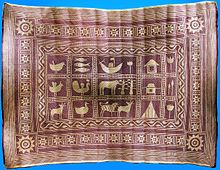Sitalpati (Bengali: শীতল পাটি, Sylheti: ꠀꠖꠤ), also called sital pati, sittal pati and adi (in Sylhet Region), is a kind of mat which feels cold by nature. It is made from murta plants (Schumannianthus dichotomus). It is usually used in Bangladesh (and to a lesser extent, India's West Bengal). Mats with decorative designs are called nakshi pati.[1]
 Sheetal Pati Self Weaving | |
| Type | Carpeting |
|---|---|
| Material | Murta plants fiber |
| Production method | Weaving |
| Production process | Handicraft |
| Place of origin | Bangladesh |
| Traditional art of Shital Pati weaving of Sylhet | |
|---|---|
| Country | Bangladesh |
| Domains | Traditional craftsmanship |
| Reference | 01112 |
| Region | Asia and the Pacific |
| Inscription history | |
| Inscription | 2017 (12th session) |
| List | Representative |

Sitalpati are made from cane or from murta plants, known in different places as mostak, patipata, patibet and paitara. The murta plant grows around water bodies in Sylhet, Sunamganj, Barisal, Tangail, Comilla, Noakhali, Feni and Chittagong. Nakshi pati made of murta plants is available only in Sylhet and Noakhali districts of Bangladesh. In India, Sitalpati is made in the northern Cooch Behar district of the state of West Bengal. Among the areas of Cooch Behar where Sitalpatis are woven, Sagareswar, Ghugumari and Pashnadanga are important centres. [2]

Recognition
UNESCO has recognised the Traditional Art of Shital Pati weaving of Sylhet and included it in the Representative List of the Intangible Cultural Heritage of Humanity.[3]
See also
- Nakshi kantha, decorative quilts made from cloth
References
External links
Wikiwand in your browser!
Seamless Wikipedia browsing. On steroids.
Every time you click a link to Wikipedia, Wiktionary or Wikiquote in your browser's search results, it will show the modern Wikiwand interface.
Wikiwand extension is a five stars, simple, with minimum permission required to keep your browsing private, safe and transparent.
